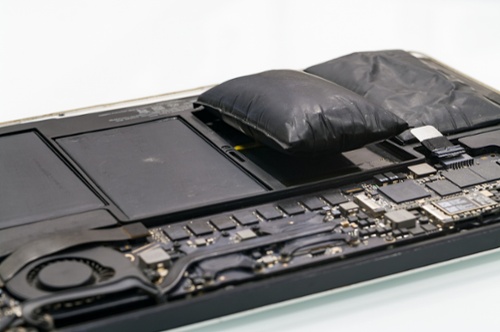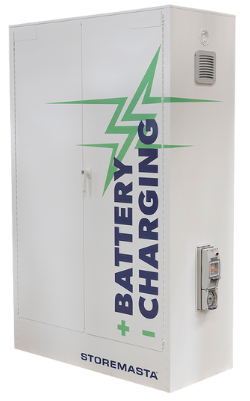Lithium-ion (Li-ion) batteries have become a necessary energy source for all types of industries. Whether they’re powering your drones, industrial robots or electric vehicles, Li-ion batteries are an increasingly popular battery in our tech-savvy workplaces. The popularity of these batteries is primarily due to the long lifespan, exceptional run time and fast charging ability of these high energy density products.
However, there are certain things that you should avoid doing if you want to retain the safety and effectiveness of your rechargeable battery. As you may already know, Li-ion batteries can pose a range of risks in the workplace if they’re exposed to extreme heat, humidity, overcharging or impact damage. And we hear so many questions from workers, such as 'Is it OK to leave a lithium-ion battery on the charger overnight?' So, to help you look after your Li-ion battery cells, we’ve put together a list of 8 things you shouldn’t do with your batteries — from leaving cells in the sun to ignoring the battery charge time.
If you want to learn more about lithium-ion battery safety, keep reading to find out what not to do in your workplace.
Don’t # 1. Leave Batteries In The Sun
Lithium-ion batteries should never be kept, operated or charged in hot environments. It’s recommended that the ideal temperature for Li-ion batteries is a cool, comfortable 15°C.
Elevated ambient temperatures can trigger thermal runaway in batteries – which is when the heat generated within the cell is greater than the heat that is dissipated from the battery. Thermal runaway will not only destroy your lithium-ion battery, it will also contribute to the risk of fires or explosions.
To avoid this issue in your organisation, make sure that your staff are trained to safely handle, charge and store your Li-ion batteries. This includes ensuring that your batteries are always kept in moderate temperatures — free from humidity. That means that they should never left lying around in outdoor areas or in direct sunlight.
Don’t # 2. Use Old Batteries
When was the last time you inspected your lithium-ion batteries? Just like any piece of equipment in the workplace, it’s important to monitor the condition of your batteries to ensure that you’re not charging up an aged battery cell.
If your Li-ion batteries are nearing their end-of-life, they can create hazards for your workplace. While this type of battery is known for providing a longer lifespan than other batteries (such as lead acid), they do have a limit as to how many cycles of charging and discharging they can perform safely. If your batteries have been used extensively, you should implement an inspection and disposal system to take your aged batteries out of daily use.
Old batteries are more prone to deterioration and damage, which can create issues such as overheating and battery fires.

Lithium-ion battery fires are difficult to extremely hot, fast burning and very difficult to put out.
Due to the increased prevalence of this type of battery in both the workplace and the home, there are a multitude of environmentally-friendly recycling options available across Australia. Check with your local recycling organisation to find out the best way to recycle your end-of-life lithium-ion batteries.
By choosing to recycle, you’ll not only be limiting landfill, but you’ll also be keeping your workplace safe by retiring your aged batteries.
Don’t # 3. Store Batteries For Long Periods Of Time
As a rechargeable battery, lithium-ion products are designed to be regularly charged and discharged. Manufacturers generally recommend that you don’t leave your batteries unused for long periods of time. If your stores have been untouched for about 6 months, it’s imperative that your staff inspect and check the battery before they are put back into rotation. It’s recommended that you review the charge status of your battery before determining whether to dispose of the battery or recharge it once again.
Li-ion batteries are known for their long lifespans – which can be around 3 years or up to 500 charge cycles. However, just like any battery, their operational capacity is finite, and they will become less efficient (or completely unusable) over long periods of time.
To maintain the lifespan and effectiveness of your battery, schedule routine inspections to see the charge status and create a regular cycle of charging and discharging. This will assist in keeping your battery in good working order and performing at the optimum level.
Don’t # 4. Ignore Swollen Cells
Have you ever been unfortunate enough to notice a swollen lithium-ion battery? This definitely isn’t a problem that you want to sweep under the rug.
Whether it’s a swollen battery in your iPhone or a swollen cell for your power tools, this isn’t a malfunction that should be ignored. Swollen batteries are a sign that something is wrong with your cell.

Swollen lithium-ion batteries are a sign that your battery may leak or explode.
A number of issues can cause your Li-ion battery to swell up or split open.
These can include:
- Exposure to high temperatures
- Impact damage to the battery
- Deep discharging
- Manufacturing defects
Due to this damage or defect, there is a build-up of pressure within the battery cell. This pressure then causes the battery to swell — resulting in often unexpected incidents such as fire and explosion.
Due to this risk, immediate action should be taken if employees notice a swollen battery. Contact your battery disposal service for advice on how to safely dispose of the swollen battery. In some cases, you may be able to safely remove the discharged, swollen cell from your device or equipment – and place it in a cool, dry container, ready for disposal. However, we recommend getting expert advice before you attempt to remove your lithium-ion battery.
In any case, great care must always be taken by staff who are attempting to handle swollen batteries. An accidental puncture or knock could cause the battery to rupture, which will cause human harm and property damage.
Like to learn more about battery safety?
Don’t # 5. Use Unsuitable Chargers
You’ve probably heard this all before, but make sure that you’re using a battery charger that’s suitable for the lithium-ion battery that you’re recharging. Referring to the battery manufacturer’s instructions will help you select a battery charger that is best suited to your specific battery.
While imported models may appear more affordable, they may not meet national safety regulations. Therefore, be sure to look for a quality battery charger with built in protection from overcharging.
You should also regularly inspect your chargers to ensure that there is no noticeable damage. Just like damaged batteries, old or damaged chargers should be disposed of in a safe and suitable manner.
Don’t # 6. Charge Damaged Batteries
If you have an old, swollen or damaged battery, putting it on charge is only going to exacerbate the risk of leaks, fire or explosion. As part of your battery management plan, you should always inspect your batteries before you place them on charge.
Choosing a battery cabinet for your lithium-ion batteries can also assist with safety during the charging process. These purpose-built battery cabinets may offer a range of controls to ensure safe charging conditions including ventilation, temperature regulation and electrically certified circuitry.
Battery charging is made safer when using a lithium-ion battery cabinet.
Don’t # 7. Not Consider Fire and Heat Protection
A workplace fire is a disastrous occurrence, regardless of the type of dangerous goods that you have onsite. However, when you add a store of lithium-ion batteries to the mix, the level of risk can dramatically increase.
As batteries that are sensitive to extreme heat, Li-ion cells can react dangerously when exposed to the radiant heat of a workplace fire. With the safe temperature range for lithium-ion batteries falling somewhere between 5 and 20°C, the heat of a fire can cause catastrophic damage if it penetrates your battery store.
Overheated batteries can spark thermal runaway, which can quickly travel through your entire battery store. This thermal runaway will only increase the hazards associated with the workplace fire. The overheating and explosion of batteries will only contribute to the severity of the battery fire blaze — which is a notoriously difficult type of blaze for firefighters to extinguish.
While the process of thermal runaway can’t be stopped once it has commenced, you can limit the damage a fire may cause in your work areas by ensuring your battery store has a heat and fire barrier.
The barrier is designed to allow personnel a small window of time to action emergency evacuation procedures and utilise fire extinguishing equipment.
Don’t # 8. Ignore Battery Charge Time
To wind back to our original question in the intro to this blog, 'Is it OK to leave a lithium-ion battery on the charger overnight?' The answer is, 'No'. Overcharging your battery is not recommended, with overcharging being a factor in battery fires and unsafe lithium-ion charging practices. We recommend monitoring the state of charge and ensuring that your battery is not fully charged or fully discharged.
Always turn off your battery when it's near full charge, unplug all equipment and keep the charger in a safe locattion until it's next required. Lithium batteries should not be left on charge - and when they're charging - they should always be charged on a non-combustible surface, with the appropriate charger. You must also give consideration to the ambient temperature of the area, and ensure the location has adequate ventilation and is not too humid.
Have you noticed that your battery is taking longer to charge? This could be a sign that either your charger or your battery requires immediate attention.
Longer charging times can often indicate an issue with the functionality of the battery. This can usually be attributed to the age of the battery — and the fact that the cell has lost its ability to charge.
Monitor the charge time of your batteries and dispose of any old or faulty batteries to reduce your risk when recharging.
Should You Leave Your Batteries On Charge?
With more applications for Li-ion batteries in the home and the workplace, it’s never been more important to understand how you can minimise your risk. As we’ve touched on in this post, there are many things that your staff can do to reduce the likelihood and impact of fire, explosion and thermal runaway. However, one of the easiest ways to control the hazards associated with Li-ion batteries is to provide a cool, dry and secure store — such as a battery cabinet.
While it's still vital that batteries are inspected and monitored during the charging process, so they aren't subject to damage, impact, unsuitable charging equipment, rough handling practices or overcharging, a suitable battery cabinet or outdoor store will provide the necessary controls to reduce battery fire risk.
If you’re interesting in finding out more about risk reduction, why not access our free guide? The Safe Charging and Storage of Lithium-ion Batteries offers helpful advice and practical tips to reduce risk in your battery handling and storage areas. Grab your copy of our guide today to learn more about managing the risks associated with Class 9 Li-ion batteries.

Living life by the 4 C’s of marketing – communication, coffee, compliance… and more coffee – Leisa Andersen is Storemasta’s Content Marketing Manager. When she’s not writing, you’ll find her enjoying all the good things in life, including shopping, travel and gluten free donuts.

